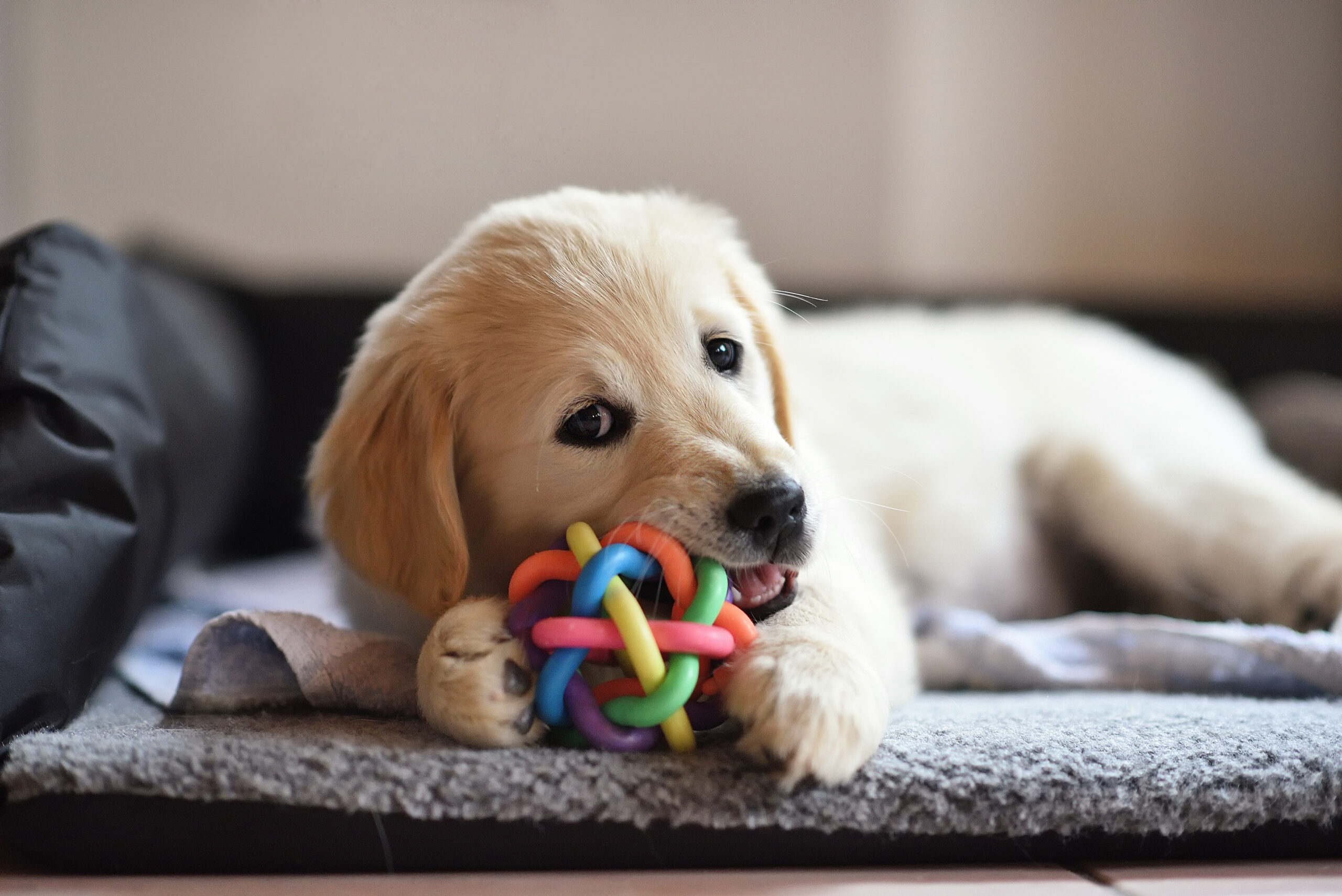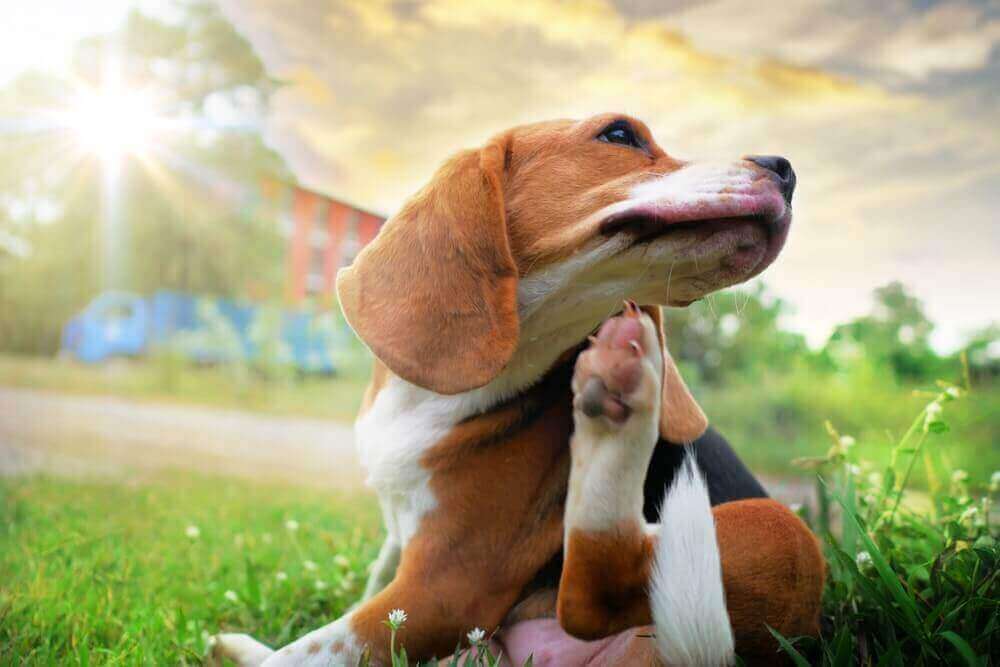Hey Ollie blog readers! We’re offering you an exclusive 60% OFF your starter box! Try now!
If you were hoping for an easy and precise answer, sorry to disappoint but the answer to this question is a bit more complicated. If you have children, you probably know your kids (and their friends) progress at a different pace. Everything from first words to first steps and even things like reading and numbers happen at a different pace. The best thing you can do when you get a puppy is to let them explore and learn at their own pace. This will help you raise a dog that is eager to learn.
While we can’t give you an exact answer, other than hopefully your dog spends their entire life learning, we can give you some tips and tricks to help your dog pick up the basics faster!
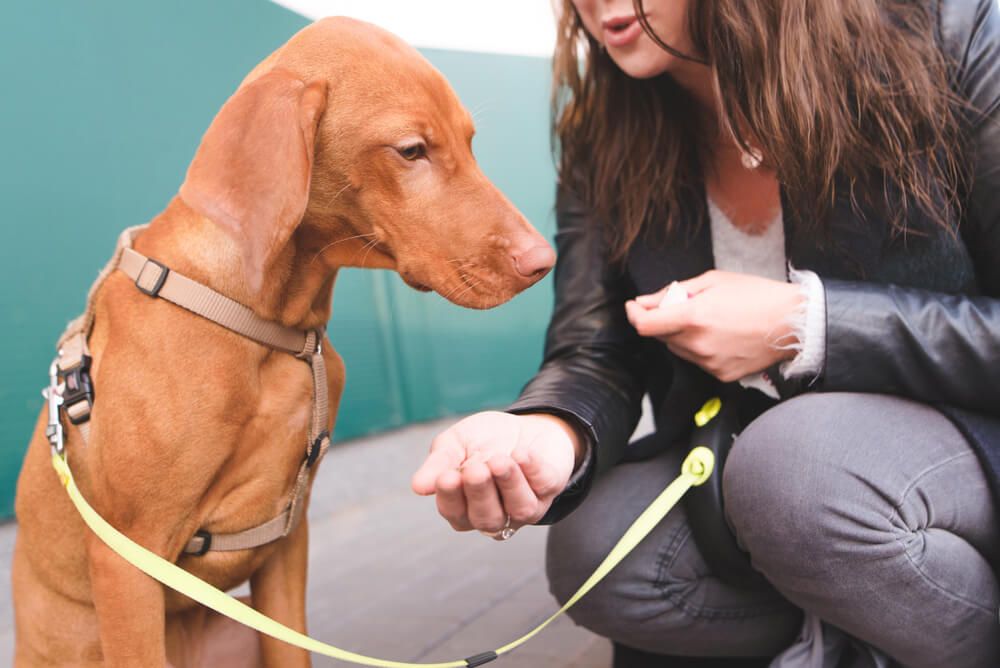
How do I ensure my dog loves training?
This one is simple, make it fun and rewarding. You want to create an environment where your pup gets excited about training. In order to do this, you may want to invest in a treat pouch. You will wear this pouch (full of magically delicious treats that appear during training) a lot. Put it on when you take your dog outside or for a walk. Grab it and leash up your dog to work on basic obedience commands. Wear it when you introduce your dog to something new. The point is, you want your dog to get excited when they see the pouch and know that when you put it on you’ll be practicing or learning something new!
Some handlers also use a clicker. This tool makes a sharp clicking sound. It is used to reinforce when your dog does something correctly. This is the same concept as using a marker word like “yes”. If you do any trick training with your dog, the clicker will be helpful in reinforcing precise movements as you can sometimes click faster than you can say yes. In order to use the clicker with your dog, you need to “charge” it first. This means teaching your dog the click is good. The simple way to do this is to click and give your dog a treat. Keep doing this without any commands until your dog understands that the click means a treat is coming. Once your dog has that down, ask your dog something easy that they know like a sit. Then click and treat when your pup sits. From here, you can start to incorporate the clicker into your training.
If your dog is giving you vibes that they aren’t interested in training, its okay to take a break or delay your training session. By letting your dog decide when they want to train, you’re setting them up to enjoy training more. Keep sessions short and interesting so your dog stays engaged. You also want to end your sessions on a positive note, even if that means simply ending your training with a few basic commands.
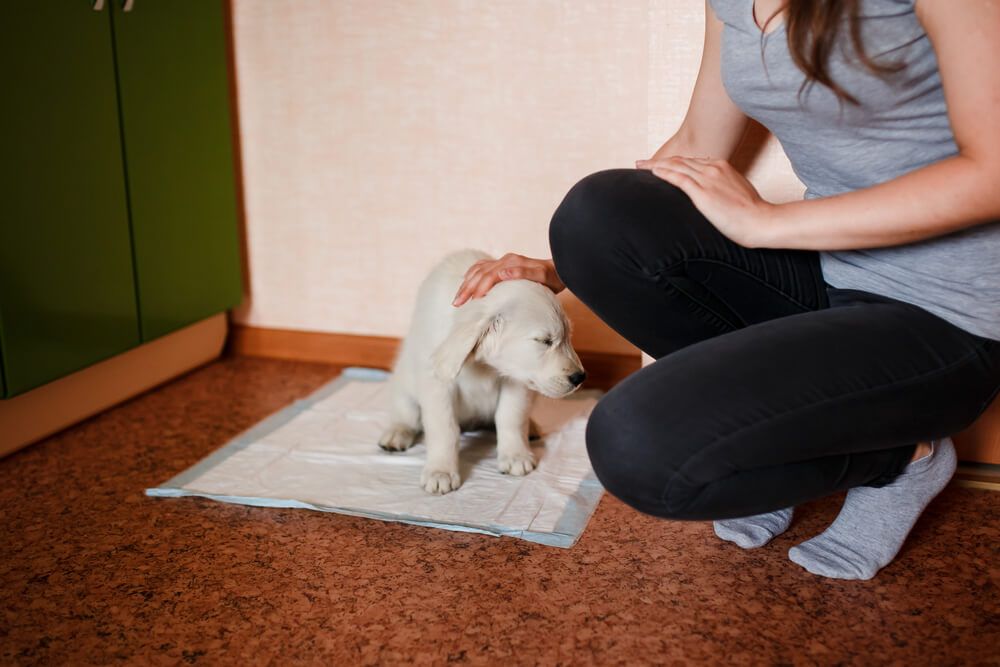
What should I train my puppy to do first?
House Training
When you first bring home a puppy or new rescue dog, you will want to teach them the things that will help them settle into your home. Start by creating a rough schedule for the puppy. When will you feed them and when will they have time for walks? With young puppies, they need to be walked as soon as they wake up, after meals and every 20-30 minutes when they are awake or right after vigorous play. This sounds like a lot of walks, and it is, but remember that puppies sleep a lot too. If your puppy is napping let them rest.
By being proactive about walks, your puppy will eventually start to tell you when they have to go. If you always take them out a certain door, they may start going to that door. Some dogs also bark or are trained to press a button or ring a bell. However you choose to communicate with your dog, by taking them out before they can have an accident you are helping them understand that they should go to the bathroom outdoors.
Accidents do happen, especially with small puppies. Until they are fully house trained, keep them in an area where if they have an accident it is easier to clean up, and supervise your puppy closely. Do not smack your puppy or rub their nose in an accident, these training methods are outdated and inhumane.
Crate Training
When your puppy comes home, you will want to start crate training right away if you are planning to use a crate. To get started, put a blanket or mat in the bottom of the crate so it is very comfortable for your dog. You also may want to cover the crate on 3 sides like a cozy cave. This may help your pup feel secure.
To get started, open the door to the crate and sit next to it. Call your pup over to check it out. You can toss a few yummy treats in the crate to help entice your pup to walk in. Once they do, offer praise and maybe another treat.
As your pup grows more confident or starts going into the crate on their own, you can start to practice closing the door. Stay in the room and offer praise and treats.
Once this becomes easy, start working on creating some distance, until you can leave the room with your pup in the crate. Start with short durations (10-15 seconds) and work up to short errands. You may want to leave the TV or some music on when you are away from your pup so they are not sitting in silence.
When you come back, no matter if you were gone 15 seconds or 20 minutes, offer praise and rewards. Remember to give your pup a potty break after some time in the crate.
Depending on your dog’s age and how they were raised this process could take anywhere from a few days to a few weeks. You can work up over time to the maximum hours your pup can be in the crate. For most new puppies, that is about 3 hours.
Keeping your puppy in a crate for most of the day is not recommended as puppies from 12-16 weeks are in a crucial period for socialization. If you need to be away from a young puppy for work, we recommend a dog walker or experienced pet care professional to help you give your puppy much-needed breaks and socialization.
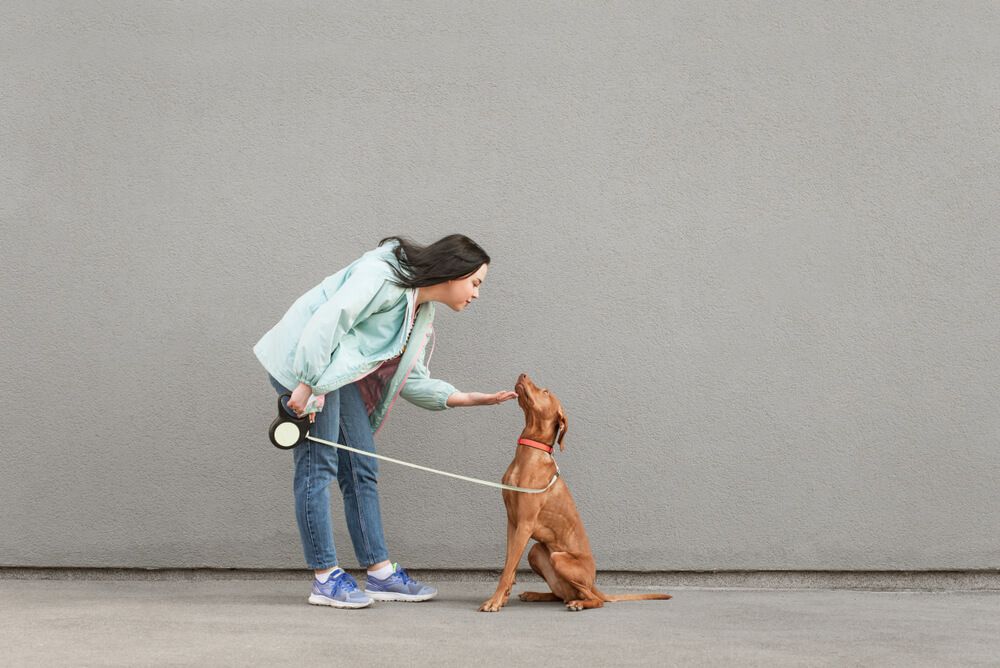
Obedience Training
Next up on our list is obedience skills. You want to be able to control your dog when you need to. This does not mean dominating your dog. You want your dog to know how to listen to you when you need them to. A good puppy kindergarten class should be able to help you and your pup understand these concepts in about 6 or so weeks. That said, think of training classes as a workout, you can’t just show up once a week for an hour and expect to get better. You will want to work some short practice sessions into each day with your pup!
The most important skills to work on during this time are:
-
- Sit/Down
- Stay
- Come
- Drop it
- Leave it
- Walking politely on a leash
- Walking past other people and dogs
Look for a certified dog trainer who uses positive reinforcement or fear free methods. You also want to find someone you and your dog enjoy working with who makes training fun.
While all of these skills can be completely taught at home, there are some benefits to taking a group class. First, you and your dog will meet other puppies and their owners. Second, your dog will learn to work in other environments. Dog’s don’t generalize well so if you teach them sit at home, you will also want to practice in other places, like a group class. Third, working around other dogs can help your puppy focus in a distracting environment. Focusing on you and the teacher instead of the other puppies and new smells is hard work!
Social Skills Training
In addition to learning the obedience basics, you will want to work on social skills with your puppy. These include appropriate interactions with people of all ages, other dogs, other animals if your dog is likely to encounter them and objects.
You may be curious about socializing with objects. What does this mean and how do you do it? Ever see a dog who was afraid of bicycles or skateboards? Exposing your dog to as many objects as you can when they are little will help build confidence so you have a less fearful dog. Some common popular objects to socialize include:
-
-
- Different surfaces (grass, carpet, hardwood flooring, or concrete as well as uneven surfaces)
- Cars (going inside and walking near them)
- Bicycles
- Skateboards
- Trash cans
- Swimming pools (water safety first!)
- Balls
- Strollers
- Wheelchairs or mobility aids (crutches, canes, walkers etc.)
- Other objects your dog will frequently come into contact with
-
When you have a new puppy, or bring home a rescue everyone will want to meet him or her, so socializing with people should be pretty easy. Be careful not to overwhelm your dog with too many new people at once. Try to introduce your puppy to people slowly, starting with the people they will see most frequently. Consider young people (always supervise dogs and children), older people, teenagers and people of all genders and races. You will also want to make sure your pup has a good intro with the vet, groomer and anyone who may care for them in your absence.
Like people, dogs have their own unique personalities. Some enjoy socializing with other dogs and others prefer the company of humans (or themselves). This is why you will need to help your puppy understand social cues. In many puppy kindergarten classes, the instructor will provide supervised off leash playtime to allow the dogs to interact. While this is one of the most adorable parts of any puppy kindergarten class, it serves a really important purpose. The puppies are learning how to play and interact. You will want to pay attention to any guidance your teacher is giving during this portion of class. They may ask you to give your puppy a break or guide them away from another puppy. This may be because your pup or the other is either overstimulated or looks like they’re not having fun or are scared. Ask the teacher to explain what they are seeing (if they don’t) so you know what to look for when you’re out walking your dog if another dog approaches.
When it comes to other dogs and people, you should be your dog’s advocate. If you know your dog prefers not to be pet or interact with another dog, SAY SO. Just because someone asks to pet your dog or if their dog can say hello, you are allowed to say no. Even if the person pushes, its okay to be firm with your response and not give in. Also, if your dog is saying hello to another dog and either dog snap, growls or otherwise shows they want the interaction to end, its okay to simply end it.
This is especially hard for puppies, they may see all other dogs as friends. That is – until your puppy goes barreling up to an older dog at full speed and gets put in their place. While this warning is healthy dog communication, you certainly do not want it to escalate.
Leash Training
Yes, you actually do need to teach your pup to walk on a leash! This is one of the lessons that can actually be a lot more complicated than it sounds.
Young puppies may think their leash is a chew toy. This is not a great habit to develop as you don’t want to risk your pup biting through their leash or being distracted when you are walking and risk an injury to you or them. You also do not want your puppy to pull on the leash. This can cause injury or you could be separated from your dog if you are surprised and not holding on tight enough.
You will want to practice walking on a loose lead with your pup. This means there is some slack in the leash and your pup is following your commands and turning and stopping with you. Start working on this at home with no distractions and work your way up to expecting this behavior on walks.
You might find that there are still some places, like the last few feet to the pet store or another family member’s house that your dog gets really excited and starts to pull ahead. Keep working here and let your dog know that fun things happen when they don’t pull you!
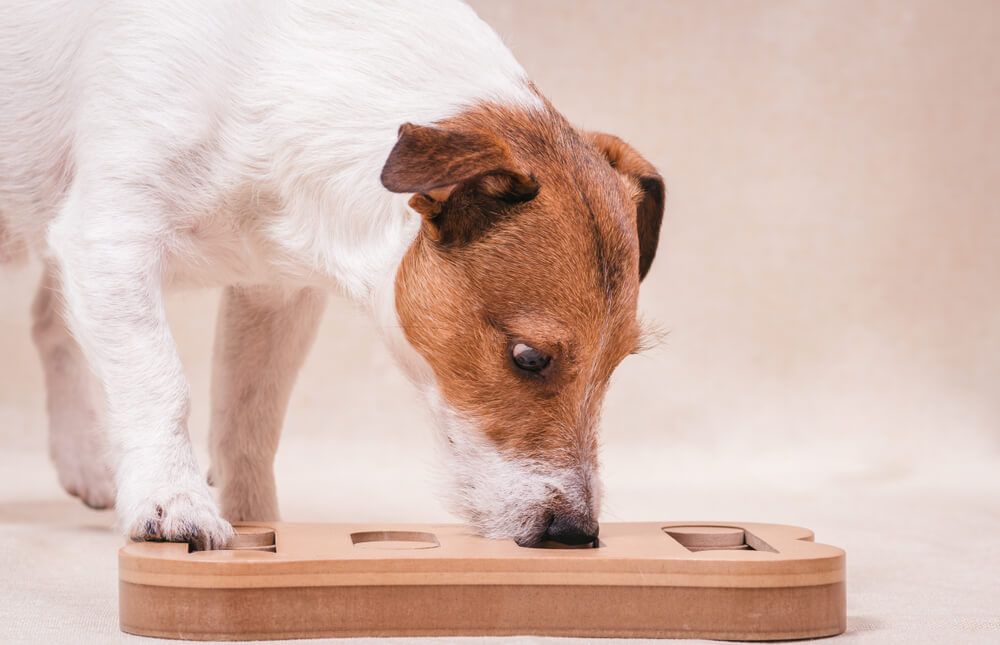
Beyond the basics
This is when all the fun really begins. Teaching your dog the basics can help you both bond as a team and build your puppy’s confidence but once you have a good foundation you can work on so many other things. The answer to this question really depends on what you and your pup like to do for fun!
Does your dog need a job to do?
If your dog likes to work, consider teaching them some tricks like turning off the light, cleaning up their toys or getting you certain objects. You can even teach your pup to fetch you a drink!
If your pup is feeling competitive, you can teach them a game like tic, tac, toe or bowling. While they may not really get into the game, it will certainly impress the neighbors!
Depending on how quickly your dog learns, these can take anywhere from a session to a few months to teach.
Does your dog like to entertain?
If your dog loves the spotlight consider teaching tricks like play dead, jump through a hula hoop or even how to pick a pocket!
Get creative and string a few tricks together to tell a story. If you are interested in competing for AKC trick titles – these skills will come in handy.
Does your dog jump off your couch like Evel Knievel?
If your dog has a bit of daredevil in them, consider some dog sports. Do you think your dog might enjoy speeding around an agility course or dock diving? How about chasing a lure or flyball? Whatever your pup’s athletic passion is, there is something for you to try together.
Learning the basics of a dog sport can happen pretty quickly — but how far you go is up to you and your pup. Some dogs can train in their sports for years and continue to learn and improve.
What happens if my dog isn’t “getting it”?
First, don’t panic. No matter where you are in your training, if your dog isn’t getting what you’re trying to teach or they make mistakes, there are plenty of things you can do.
1. Make sure your cues are clear
If your dog is having trouble with what you’re asking, make sure you are giving clear cues. This becomes especially important as your pup gets more advanced. For cues like sit and down, try to only say the verbal cue once and wait them out. If you repeat yourself your pup may decide to wait until the 4th or 5th time you ask.
2. Try another way
If your pup is still struggling try another way. For example, some dogs struggle with down. If you have them crawl under your legs or a chair for a treat… they will find themselves in a down position! Then you’ll work to fade that lure out and work on down from just the verbal command.
3. Take a break
If your pup has trouble focusing, try ending the session and coming back to it when you’re both feeling focused. Try to end on a positive note so your pup looks forward to working with you again.
4. Get some (professional) help
Still struggling? Call a trainer for a private lesson. A qualified trainer can help you where you’re stuck and give you some things to work on together. Having a trainer give you some feedback can be helpful as a set of fresh eyes. They also should have the experience of working with many dogs so they will be able to help you come up with a plan that will best suit you and your pup.
5. Keep practicing
Even if your dog doesn’t master the hardest tricks, keep working together and having fun! It is not important that your dog be perfect, but it is important that they are happy, healthy, and engaged mentally as well as physically. The only caveat to this is if your dog is not learning something that is important to their health or safety – discuss your concerns with a trusted professional like your vet, trainer or a veterinary behaviorist!
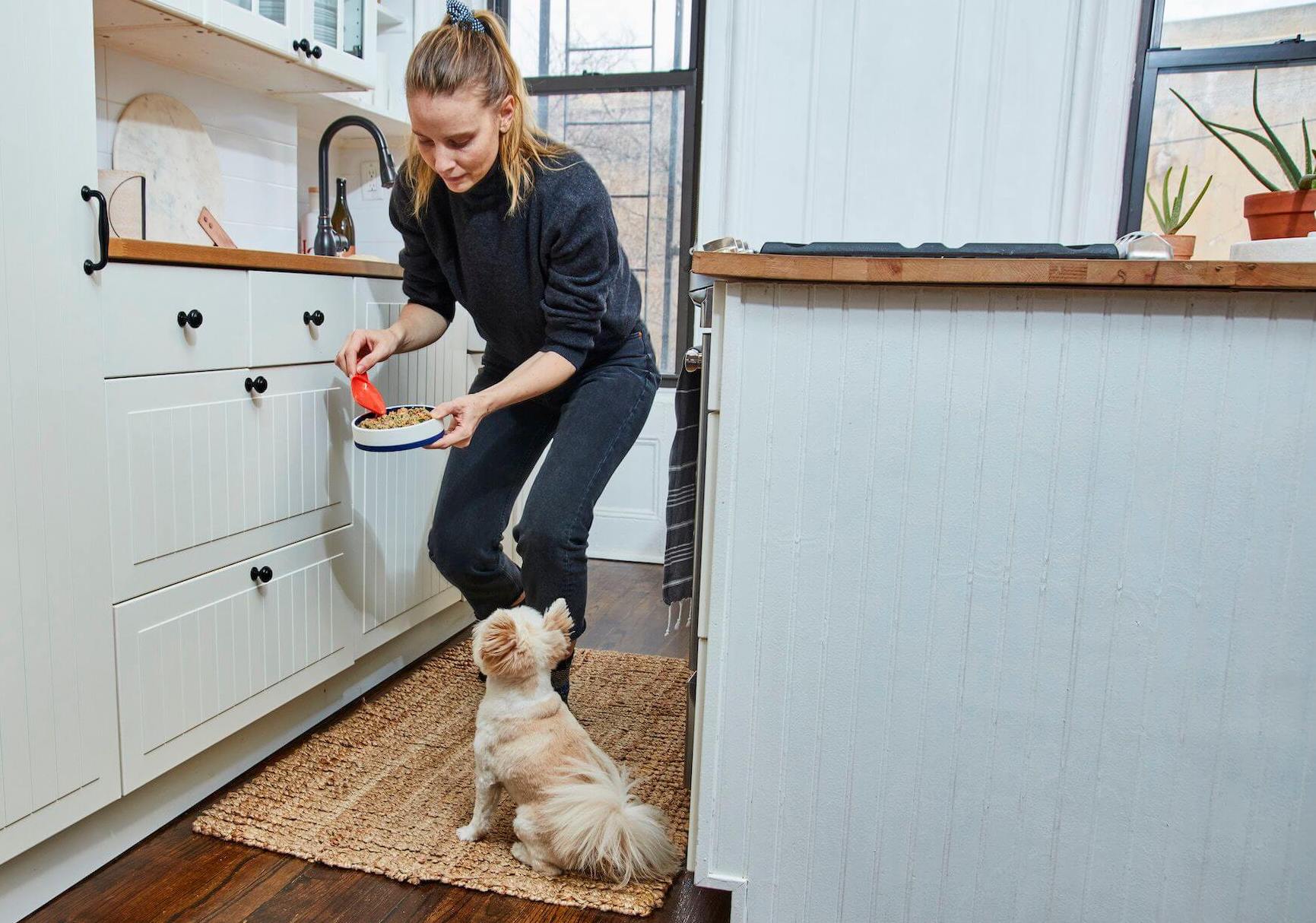
How does nutrition factor into my training plan?
If you are training in agility or another dog sport, giving your pup foods that nourish their body is important to their performance. Even if your training is not particularly athletic or you’re just getting started there are a few important considerations you’ll want to make on the feeding front. First, make sure your dog is eating enough. Like you, working while hangry is probably not going to end well. Your dog should be nourished enough that they have the energy to work and focus on you. The other consideration is treats. If your dog is food motivated, you might use some higher value treats like cheese, hot dogs, low sodium lunch meat or peanut butter as a reward for a job well done. These foods are generally fine in moderation, but consider reducing your pups meals or portion sizes on the days you train. If your pup is looking to lose a few pounds or you just want a healthier treat, consider using fresh fruit or veggies your dog likes. For a non-food reward you can try a favorite toy like a ball or tugger for a few moments of fun.
At Ollie, we obviously know a thing or two about nutrition. To keep your pup nourished and in the best shape consider letting us customize a meal plan just for them. Take our quiz and we will share a recommendation for the right delicious recipes and portion size for your pup. The food is delivered straight to your door for your convenience and your pup’s dining pleasure.
The Ollie blog is devoted to helping pet parents lead healthier lives with their pups. If you want to learn more about our fresh, human-grade food, check out MyOllie.com.
Tagged As:

The nutrition your dog needs,
the food they want.

Enjoying our articles? Subscribe our Newsletters and get new articles directly to your inbox
You might also like
13 May 2025
8 MINS READ
Puppy Training Guide & Behavior Timeline
Bringing home a puppy is pure magic. It’s also pure chaos—tiny teeth, zoomies, accidents in the house, and moments that make you wonder if you’re raising a future genius or a tiny tornado. …
by Ollie Pets
10 May 2025
12 MINS READ
New Puppy Checklist: Guide To Prepare For A New Dog
Bringing home a new puppy? This checklist covers everything new dog owners need—from essential supplies to training, feeding, and first vet visits.
by Ollie Pets
3 April 2025
9 MINS READ
Home Remedies for Fleas on Dogs: 10 Natural Ways That Actually Work
Wondering what kills fleas on dogs instantly and naturally? If your pup is scratching like crazy, it may be time to take action. In this guide, we’ll show you the most effective home remedies for…






